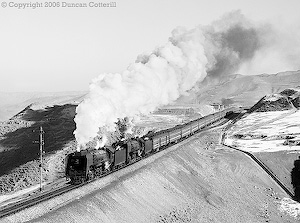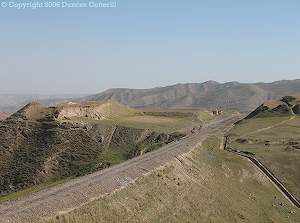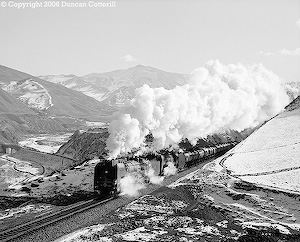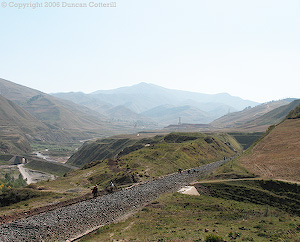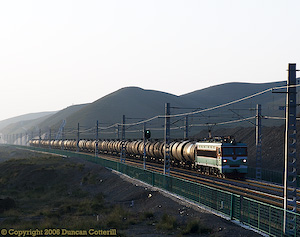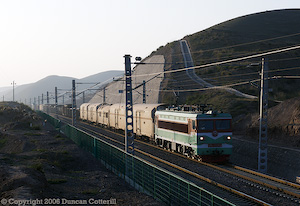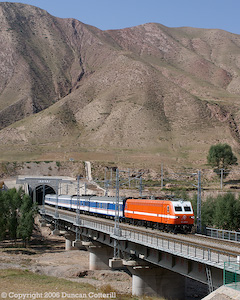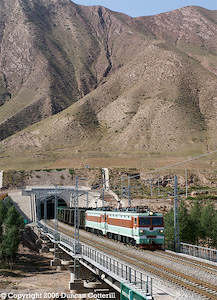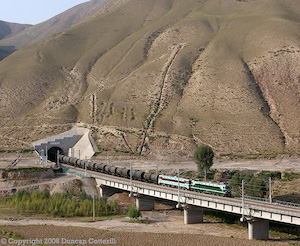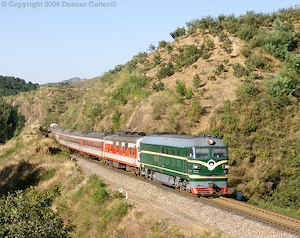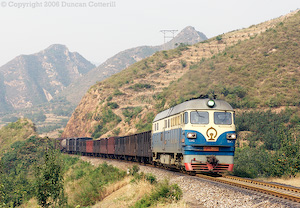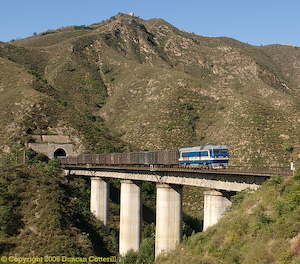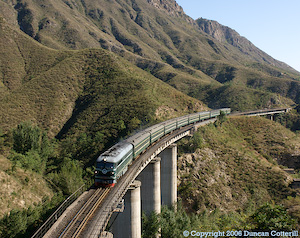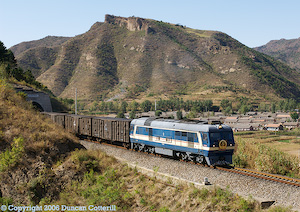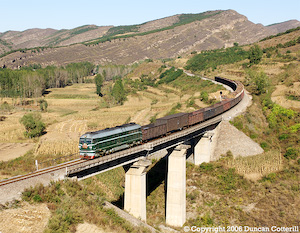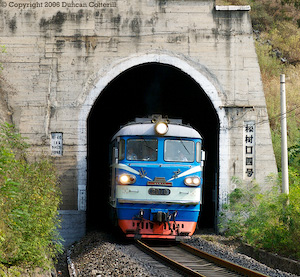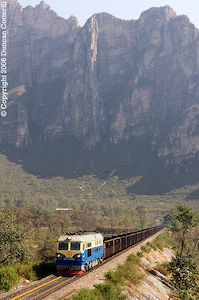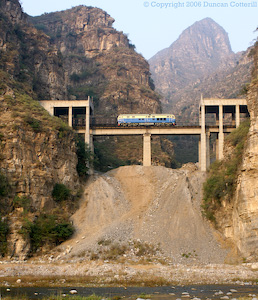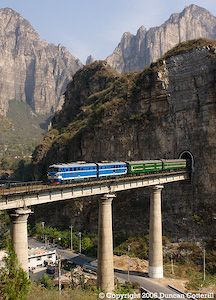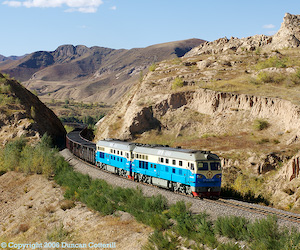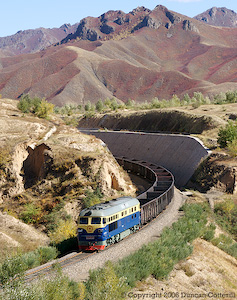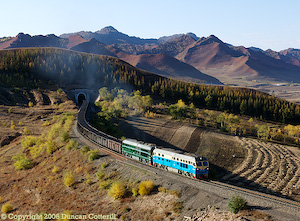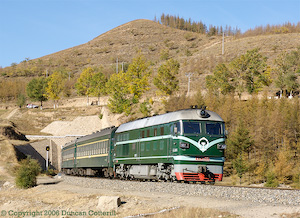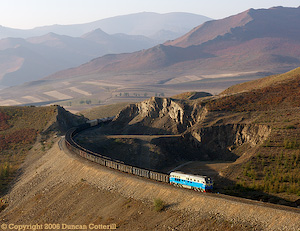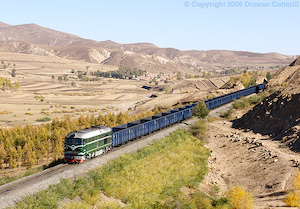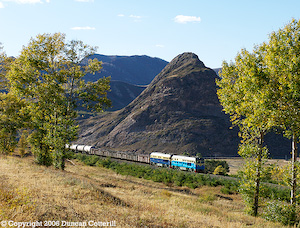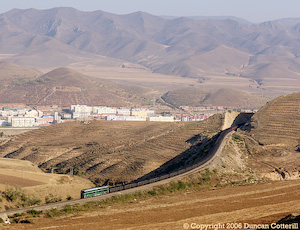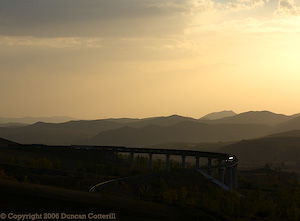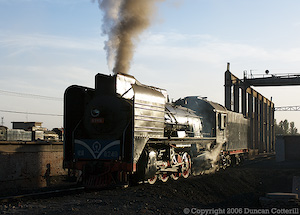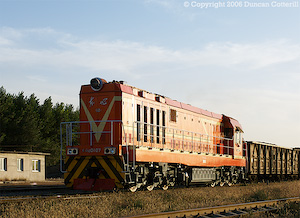Modern Traction in China
20 September - 08 October 2006
Report by Duncan Cotterill
Introduction
With no QJs on the Jitong Railway this autumn, my thoughts turned to photographing China's diesels and electrics. Steam is now confined to industrial operations and I was beginning to miss the excitement of photographing big trains on scenic main lines. China has a remarkably varied modern traction scene and those used to seeing nothing but QJs, JSs and SYs might be surprised at the plethora of different diesel and electric classes in use. For my first modern traction trip to the middle kingdom, I didn't attempt to maximise variety but chose five lines with good scenic potential including one threatened with imminent closure and one with rare diesels on some passenger workings. As usual, the trip was organised through Sun Xiaolan of CLSLPA.
The Outward Journey
(Wed 20 - Thu 21 Sep 2006)Uneventful is the best way to describe the journey from home to Heathrow then onward by Air France to Paris and Beijing. The flights were within a few minutes of right time and all the formalities and security checks went smoothly. At Beijing I met up with my guide for the trip, Zhuang and we took China Eastern flight MU 2434 to Lanzhou. Again the flight was almost on time and we were on the road north with driver Li by 15:00.
Wushaoling
(Thu 21 - Tue 26 Sep 2006)Until the Qinghai - Tibet Railway opened in the summer of 2006, the highest point on the Chinese rail system was Wushaoling summit between Wuweinan and Lanzhou on the line from Wulumuqi (Urumchi). Southbound trains faced over 50 km of hard climbing, much of it at 1 in 50, from Gulang to the 10,000 foot summit. En-route the line passed through many tunnels, crossed numerous viaducts and looped around no less than five horseshoe curves as it clawed its way out of the Gobi Desert up onto the northern ramparts of the Tibetan Plateau. This was the legendary Tianzhu, one of the railway wonders of the world and one of the few Chinese lines to match, or even better, Jingpeng Pass in its photographic potential.
In steam days Tianzhu lay in a closed area and getting permission to visit was problematic at best and usually downright impossible. Those who got there found pairs of QJs being worked to the limit on heavy freights and long passenger trains through magnificent scenery, a sight and sound never to be forgotten. Electrification between 1990 and 1992 brought the steam era to an early close and Tianzhu faded from the gricer's radar.
My interest was reawakened in late 2005 when returning by train from Sandaoling to Lanzhou. Leaving Wuweinan it became clear that major changes were underway. The tortuous, steeply graded, single-track line was clearly a bottleneck on the strategic route linking Xinjiang with the rest of the country. Electrification on its own had not proved to be an adequate long-term solution and double tracking had been proposed for many years. There had also been rumours of a base tunnel being constructed. I had assumed that any double track would follow the existing alignment and the base tunnel was a long-term project that wouldn't be realised for many years. Wrong! This was 21st Century China and "build it big, build it now" was the motto.
A brand new double track railway had been opened during 2005 from Wuweinan past Gulang to Longgou, eliminating the lower section of the original main line. The new line was engineered to high standards with tunnels and viaducts used to maintain a modest gradient and avoid sharp curves despite the rugged terrain. At Longgou we rejoined the old single-track line for the journey over Wushaoling summit but it was clear that work on a base tunnel under the mountains to Dachaigou was already well advanced. From Dachaigou to Lanzhou was again on a new, fast, double track alignment. The scenic line over Wushaoling was obviously living on borrowed time.
The first bore of the 21 km base tunnel opened in April 2006 leaving the original line to handle northbound traffic while southbounds used the new tunnel. The opening of the second bore was rumoured for October 2006.
So as we sped up the road from Lanzhou on 21 September I still expected to find northbound trains going over the top. Unfortunately it was not to be. We stopped near the southern portal of the new tunnel and found both bores already in use. The driver recalled that trains had still been using the old line in early August when he last passed this way, so the second bore obviously hadn't been open for long. Hope lingered that the tunnel might not be operating at full capacity yet and a few trains just might continue to use the old line.
The following morning that hope was well and truly dashed. We picked up the old line at a level crossing just outside Dachaigou. The complete lack of overhead equipment was an ominous sign. Not only had the wires gone but the concrete masts had all been broken off at the base and reduced to rubble. The crossing was still manned and the keeper confirmed the line's closure date as 12 August. The very last hope was that there may be demolition trains somewhere on the line but dropping down to Anyuan (as Tianzhu is now known) we found the rails being lifted and removed by road vehicles. It turned out that the overhead equipment had been removed from the whole line and the rails had been lifted from Longgou to a point between Anyuan and Qinghe. It was now clear there would never be another train over the old line.
Near Shagoutai I revisited a couple of locations where I had photographed steam at the end of 1989 and found an army of labourers attacking the concrete sleepers with sledgehammers, smashing them to pieces so that the studs and reinforcing wire could be salvaged. It is likely that this had also been the fate of the overhead masts. The speed at which a working, electrified main line was being reduced to no more than a strip of ballast and concrete rubble was staggering. What a sad fate for one of the world's most photogenic railways.
There was no point in getting upset at missing the last trains over the pass so my efforts turned to getting some photos on the new line. It wasn't particularly easy. The whole route is lined with the hideous green fences that are now a feature on most of China's main lines. Another problem is that the overhead masts are fairly closely spaced, particularly on bridges, leaving few long gaps in which to position locomotives. A handful of good locations were found on both sides of the pass although they were nothing compared to those that had been lost with the closure of the old line.
Reasonable afternoon positions were relatively easy to find on the south side of the pass between the new town of Tianzhu (formerly Huquansi) and Dachaigou and north of the tunnel between Longgou and Liujiatai. Morning shots were less straightforward with a couple of early positions east of Dachaigou being all that was found. I needn't have worried about not having enough locations to keep me busy for five days. Apart from the first day on the line, the weather was solid cloud and rain until I left the area.
Traffic was far heavier than on my 1989 visit with two to three trains each way every hour on average compared to less than one per hour in steam days. Most freight trains were longer and heavier as well. Friday, Saturday and Sunday were noticeably busier than Monday and Tuesday. The majority of freights were worked by boxy class SS3 or SS3B Co-Co electrics but the veteran SS1s also appeared occasionally. Double heading was reasonably common with any combination of SS1, SS3 or SS3B possible. Turn round times and the sighting of the same locos both sides of Dachaigou indicated that most trains now ran through from Lanzhou to Wuweinan without changing engines. Pilot engines may have sometimes been removed at Dachaigou as there seemed to be more single headers and fewer SS1s south of there.
Passenger services are far more frequent than they were 17 years ago with 13 pairs of trains a day worked by Lanzhou's orange class SS7E Co-Co electrics. At first there appeared to be a small fleet dedicated to working trains to Wuweinan as the same few locos were seen time and time again but different locos appeared towards the end of my stay in the area. On Friday and Saturday there were several diesels on the line, mainly dead DF4s coupled inside the train engine on freights. Several of those identified had Jiayuguan depot codes and were probably en-route to or from works. A Lanzhou based DF4 coupled inside an SS3 was less easy to explain. No diesels were seen on Sunday, Monday or Tuesday.
Locos seen:
SS1 373, 383, 577, 579, 580, 581, 635 (all Lan)
SS3 0003, 0006, 0007, 0011, 0021, 0285, 0364, 0393, 0414, 0415, 0416, 0417, 0418, 0437, 0592, 0607, 0608, 0609, 0613, 4201, 4215 (all Lan)
SS3B 5047, 5053, 5056, 5057, 5058 (all Lan)
SS7E 0019, 0021, 0022, 0023, 0024, 0028, 0094, 0097, 0098, 0099 (all Lan)
DF4 3971(Jia), 7085(Jia), 9177(Lan)
DF5 1375(Wu), 1862
Depots: Jia = Jiayuguan, Lan = Lanzhou, Wu = Wuweinan
The early SS3s carry the full number on their ends, e.g. SS3 0007, but the cabside plates on the same engine read SS3007, leaving some scope for confusion. Later engines carry the full number on all plates, e.g. SS3 0364.
Tianzhu to Miyun
(Tue 26 Sep 2006)After four days of miserable weather I wasn't sorry to leave Tianzhu and head back east. We returned to Lanzhou airport by road then flew back to Beijing on CA 1222 at 18:00, another flight without a serious delay. At Beijing, driver Pan met us and took us on to Miyun, 90 km north of the capital.
In the early '90s Miyun was a nondescript agricultural town and, more significantly, the place where Beijing diesels handed Chengde bound freights over to Dongmiaohe QJs for the run east through the mountains. The passengers were all diesel, even at this early stage. The QJs have been history for a decade now and Miyun has moved on as well. It's now all tall buildings, bright lights and flash cars.
Miyun
(Wed 27 - Fri 29 Sep 2006)Miyun is situated close to where the Beijing - Chengde and Beijing - Chifeng lines leave the plains and enter the mountains. Both lines traverse some excellent scenery on the way to their respective destinations.
Beijing - Chengde Line
(Wed 27 & Fri 29 Sep 2006)I had photographed the Chengde line in steam days and had a good idea where the spots were but that was in winter and this was summer and more than 10 years later. The line was a good deal more overgrown than it had been and it was often difficult to find clear spots in locations that had once been quite open.
Unlike Tianzhu, traffic had changed remarkably little since the early 1990s. There was a freight each way every 2 hours or so on average, not much more than could have been seen in steam days although the trains are probably a bit heavier now. The passenger service is also uncannily similar with two pairs of daytime expresses, two pairs of awkwardly timed overnights and two pairs of all-stations stoppers all running on virtually unchanged schedules.
Even the DF4s that worked the passenger trains in the early '90s are still around, working turn about with newer members of the same class on both passenger and freight trains. As well as the green machines there were a few blue and cream DF4s as well. These are thought to be of the little known DF4BD variant, DF4Bs rebuilt with the more modern 'D' version of the engine, as used in the DF4D.
Locos seen:
DF4 0478, 0606, 0623, 0651, 0678, 1756§, 3650§(Cheng), 6285, 9221, 9323 (all Huai unless indicated)
Depots: Cheng = Chengde, Huai = Huairou Bei
NB Chengde is thought to have become a subshed of Huairou Bei recently so DF4 1756 is probably also a Huai loco in reality. § = DF4BD
Beijing - Chifeng Line
(Thu 28 Sep 2006)This was my first photographic visit to the Chifeng line although I had travelled it in daylight and knew there were good locations most of the way from Huairou Bei to Chifeng. The main problem was getting access to a line that spends most of its time perched halfway up mountainsides in remote territory. Some excellent, and relatively accessible, positions were found just west of Gubeikou station and on the section between Hushiha and Luanping.
Freight train frequencies were a bit higher than on the Chengde line, with nine freights seen in around 6 hours by the lineside. The trains were much heavier as well, indicating that the line is much less steeply graded than its southern neighbour.
The current passenger service is seven pairs of trains a day but they are far from evenly spread throughout the 24 hours. For example, almost half the day's westbound passengers pass Gubeikou between 08:00 and 10:00 each morning. One pair of trains from Beijing Bei to Luanping and back doesn't even appear in the April 2006 timetable. The eastbound arrives Luanping sometime around 12:00 and departs for Beijing around 14:40.
Huairou Bei provides the motive power for the Beijing - Longhua section of the Chifeng line and its old DF4s are still very much in evidence despite a recent influx of DF8Bs. All the passenger trains we saw were DF4 hauled and the line's premier train, K274/275/277 from Hohhot to Hailaer, was double headed. The vast majority of freights were DF8B worked although two did produce DF4s. For the audiophiles out there, DF8Bs are noisy beasts.
Locos seen:
DF4 0430, 0451, 0561, 0572, 0577, 0638, 0693 (all Huai)
DF8B 5011, 5012, 5227, 5285, 5287, 5288 (all Huai)
Depots: Huai = Huairou Bei.
Miyun to Shidu
(Fri 29 Sep 2006)After a second morning on the Chengde line we travelled by road to Shidu. I had expected that we would use one of Beijing's ring-roads to circumnavigate the city but we went straight through the middle, taking almost 4 hours to complete the journey. The last section, along the Juma river gorge, from Dadu to Shidu, Literally First Ferry to Tenth Ferry, was spectacular.
Shidu
(Fri 29 Sep - Mon 02 Oct 2006)Shidu is around 90 km south-west of the capital, on the direct Beijing - Taiyuan railway. The line was built in the mid 1960s and follows the Juma river valley, in an approximate sort of way, for over 100 km on its way to Shanxi Province. The valley, with its precipitous cliffs and meandering course, isn't the most obvious route for a railway and the civil engineering reflects this. The builders made liberal use of tunnels to shortcut most of the river's meanders and to avoid the need for galleries cut into sheer cliff faces. As a result, much of the line is actually underground. When the track is on the surface, it's usually only for a short distance on a viaduct before it dives into the next long tunnel. The road follows the valley floor around all its twists and turns so it can take a long time to travel from one brief glimpse of the railway to the next. This was the first time I had visited or travelled on this line and the scale of the scenery and the civil engineering really took me by surprise.
Traffic was reasonably heavy for a single-track line with six freights in each direction seen over eight-hour periods on both 30 Sep and 01 Oct. Coal predominated, with many trains composed entirely of loaded or empty coal wagons. Even the mixed freights consisted mainly of coal wagons. Motive power was a mixture of DF4Cs and freight DF4Ds with a single DF4BD also seen. On 30 Sep about 50% of freights were DF4D hauled but on 01 Oct all but one train had DF4Ds on the front. All locos identified were allocated to Fengtai depot. Single heading was the norm with only one double header being seen on 30 Sep and two on 01 Oct.
Although the line links Beijing and Taiyuan, most passenger trains between the two cities travel via Shijiazhuang, a shorter and faster route. According to the timetable, the passenger service via Shidu consists of a pair of daytime Beijing - Taiyuan stopping trains, a pair of overnights and a shorter working from Beijing to Laiyuan in the evening, returning the following morning. The Laiyuan train was hauled by a Fengtai DF4D each day but the stopper to Taiyuan always produced a pair of single ended, 20xx series BJs. A second BJ 20xx working didn't appear in the timetable. This was a passenger heading west through Shidu around 12:00. An eastbound was seen at 16:00 on Sunday with a pair of BJ 20xx but on Monday a DF4D hauled passenger was seen heading east just before 15:00. These workings were not identified.
Locos seen:
BJ 2003, 2005, 2007, 2010, 2012 (all Jing)
DF4 1845, 4247, 4258, 4402, 4403, 5009, 5011, 5015, 5212 (all Feng),
DF4D 0242, 4012, 4013, 4018, 4019, 4020, 4021, 4022, 4023, 4024, 4025, 4027, 4030 (all Feng),
Depots: Feng = Fengtai, Jing = Beijing
Shidu to Reshui
(Mon 02 - Tue 03 Oct 2006)We returned from Shidu to Beijing on Monday afternoon, taking just over two hours for the journey to Xizhimen despite heavy traffic. This was a holiday weekend and most of Beijing's population seemed to be visiting Shidu for the day. The journey on to Chifeng was on train 2559 with DF4 0560 on the front from Beijing. By the time we arrived at Chifeng, a DF4C was providing the power, so locos must have changed at Longhua. A DF8B was seen on a westbound freight about 25 minutes out of Chifeng. Freight traffic east of Longhua had been DF4C before and passengers had been worked by orange DF4Bs or passenger DF4Ds, so changes appear to be underway on this section. At Chifeng we were met by driver Li, not the usual Li but his brother, and driven to Reshui, taking about 3 hours for the journey. Linxi looked busy with coal being loaded in the yard and many yellow tank wagons stabled close to the old wye.
Jingpeng Pass
(Tue 03 - Sat 07 Oct 2003)A lot has changed around Jingpeng since I was last there in December 2004. It's not just the QJs that have vanished, all the cabooses have disappeared and all the semaphore signals between Linxi and Jingpeng have been replaced with colour lights as well. Most loops have been extended and points and signals are now electrically controlled from the panel in the main station building.
Away from the railway, Jingpeng and Reshui continue to grow at an amazing rate with new buildings going up as quickly as ever. The loss of income from visiting enthusiasts may have affected the local economy but it doesn't show. A most unwelcome development is the fencing off of many hillsides on the Jingpeng side of the pass to cordon off areas where young trees have been planted. The fences run straight across many of the farmers' access tracks and the locals don't appear to have been too impressed. As a result, the fences have been broken down in many places so getting to the photo locations isn't usually too difficult.
Railway operations have also changed a bit since steam finished. Freights were generally DF4 hauled and single headed although some DF4D did appear as train engines. Heavier trains took an assisting engine on the steeper climbs. In practice this meant that almost all eastbounds were piloted from Jingpeng to Shangdian and three locos, DF4D 4244/5/6, were outstationed at Jingpeng for the purpose. About one in three westbounds was heavy enough to require assistance and was piloted as far as Shangdian, again by a DF4D. DF4D 4243 was seen on this duty several times but there may have been others as well. It was not determined whether the pilot engines were attached at Linxi or ran through from Daban. Also uncertain was whether heavy westbound trains were piloted from Jingpeng up to Haoluku. Locos heading west in the morning generally returned during the afternoon, indicating that loco changes continue at Haoluku as before. All locos recorded had Daban shedcodes and no Baiqi engines were seen.
Freights were longer and heavier than in steam days with 42 wagons being a common length and up to 50 wagons being seen. These longer trains would only just fit into the extended loops. Coal traffic predominated with about half the eastbound trains being solid blocks of coal and most of the rest consisting of around 50% coal wagons. Empty coal wagons formed most of the westbound traffic but there were also significant amounts of general freight, notably timber and tank wagons.
The stopping passengers and the express railcars were scheduled over the pass at night and weren't seen. There was an extra Huhehaote - Wulanhaote express that passed Shangdian about 08:45 every day. This train consisted of 15 green coaches including hard and soft sleepers and a diner, all hauled by a green Daban DF4. Westbound workings were seen going over the pass about 05:30 one morning and at 17:30 the next day, so there may be two additional workings on the line.
Locos seen:
DF4 0392, 0490, 0539, 0570, 0582, 0660, 1291, 3635, 6004, 6007, 6011, 6031, 6104, 6108, 9010, 9516, 9517, 9518 (all Da)
DF4D 4243, 4244, 4245, 4246, 4250, 4254, 4255, 4257 (all Da)
Depots Da=Daban
Yuanbaoshan
(Sat 07 Oct 2006)After a good morning's photography around Shangdian, it was time to return south. We travelled to Chifeng and collected our tickets to Beijing then, with a couple of hours to spare, went to Yuanbaoshan for a flying visit. It seemed improper to do a whole trip to China without seeing a single steam locomotive.
It all looked pretty normal at first with a couple of JS shunting the yard at Xizhan The shed was empty but three cold locos sat in front of the station building, all in excellent condition and looking ready to be steamed at any time. One of the power station diesels brought some coal from the power station into the yard - no, I didn't understand it either! Then a brand new, orange DF12 arrived with coal from Yuanbaoshan CNR. The loco had a "Ping Yuan" shedcode so there was little doubt that it belonged to the railway. The news that there were now 3 DF12 here had been posted after I left for China so this was a surprise. Assuming that the other duties were being covered by the other diesels, that leaves five JS unaccounted for. We didn't have time to check whether the new conveyor from the opencast site to the power station was operational yet but the rails on the bank were shiny so there is still traffic on the line up the hill.
Locos seen:
JS 8249, 8250 (in steam)
JS 6245, 8242, 8418 (cold serviceable)
DF12 0107
GKD1 4009 (power station loco)
JS 8242 was a surprise but that was definitely the number on the loco. It had full deflectors like all the others seen.
The Return Journey
(Sat 07 - Sun 08 Oct 2006)Passing Chifeng diesel depot, the usual collection of DF4B, DF4C and passenger DF4D were parked outside, along with a DF8B, confirmation that the class's sphere of operation continues to expand. Later, at the station, Tongliao's orange DF4 2305 arrived with 4272/4269 from Harbin Dong.
We travelled back to Beijing on the usual overnight train, 2560 at 20:20, and were lucky to get soft sleepers as the train was packed with people returning to the capital after the October holiday break. The hard seat coaches were wedged to bursting point. Tongliao's DF4D 0309 was on the front leaving Chifeng but Huairou Bei's DF4 0540 brought us into Beijing Bei, presumably having taken over at Longhua.
I hadn't noticed much change at Beijing Bei in the dark on the way out. There was a new high-level platform but the same scruffy station buildings remained and access was via the same potholed alleyway as previously. It appeared that the station was receiving a minor facelift. Arriving after daybreak, it was clear that a much more substantial rebuild was underway with around 10 platform roads and a new station building under construction. It does make you wonder where the trains to fill 10 platforms will serve and whether electrification is also on the cards.
After a taxi ride to the airport, I bade farewell to Zhuang and checked in for the flight back to London via Paris. Once more everything ran to schedule and the arrival at Heathrow was actually a few minutes early.
Conclusions
Wushaoling / Tianzhu was always a gamble but one that I expected to pay off, especially after some pictures of the old line appeared on a Chinese website days before I left home. In the event I was too late but that's the way it goes sometimes. Even if the line had still been open, the weather would have severely limited what I could have achieved. I'm just happy that I was able to experience the line briefly in steam days and have enjoyed three wonderful trips up the hill in the years that followed. The opening of the new tunnel may be a great leap forward in China's rail modernisation programme but it has deprived us of another fabulous line. The headlong rush towards bland uniformity continues unabated.
It was surprising how little the service on the Chengde line had changed in 10 years, especially when much of China has experienced such dramatic growth and modernisation over the same period. There was something strangely reassuring about finding the same locos working the same trains as a decade ago. It's a superbly scenic route, very convenient for Beijing and well worth a longer visit.
This was my first attempt at photography on the Chifeng line and I wasn't disappointed. The scenery looks every bit as good from the lineside as it does through a train window and there must be many more superb positions to find along the line. Another one to add to the list for a return visit.
The stars of the Taiyuan line are undoubtedly the "Da BJs", the pairs of single ended locos that work some passengers on the line. It seems remarkable that the BJ class, which had dominated passenger services around the capital for so long, has declined to the extent that the trains through Shidu may be the last booked workings for these locos. If this is their swansong, they couldn't have picked a more scenic line to bow out on. The way that the railway has been built through such difficult terrain is incredible. A trip over the route would probably be the best way to identify the best locations but a visitor to the spots around Shidu certainly won't be disappointed.
I thought Jingpeng Pass might be difficult, not because of the lack of locations, but because the memories of steam were so recent and photos of diesels in the same locations would never match up to what was possible a couple of years ago. In practice it wasn't a problem, although I did catch myself wishing for a pair of QJs on several occasions when the conditions were especially good. Of course it would have been nice if steam had continued forever but it was always going to disappear at some stage. We should just be thankful that the Jitong QJs extended scenic main line steam operation for several years and provided, for many of us, the best steam photography of our lives. Although they're not in the same league as the mighty QJs, the diesel hauled freights over the pass are pretty impressive. You can sit on the hill between tunnels 3 and 4 and listen to the growl of a pair of hard working diesels all the way from Jingpeng on a still day. As they get nearer, the whole valley fills with sound and it's almost deafening as they come past. Add to that the lack of exhaust problems due to the wind or high temperatures, the fact that downhills look as good as uphills and that the DF4Ds are far more colourful than QJs and you still have a very rewarding place to photograph trains. I'm sure I'll be going back here as well.
There has been a long running debate over which line had the most photographic potential in steam days, Tianzhu or Jingpeng. In absolute terms, I still think Tianzhu was better but much of that potential was unrealisable due to its early electrification and the problems getting access in previous years. Jingpeng, on the other hand, was the right line at the right time in the right place and as such has to win when practical considerations are taken into account. It's all academic now. There's no point in visiting Tianzhu any more but Jingpeng is still a fabulous place to photograph trains, even if they're hauled by DF4Ds and not QJs.
The arrival of the DF12s at Yuanbaoshan is disappointing but not unexpected. China's industrial lines are under intense pressure to dieselise in spite of the better economics of steam, the readily available fuel and the proven abilities of steam locomotives to do the job effectively. A steady contraction in the availability of repair facilities and spare parts and the outright hostility of CNR to having steam locos on it's lines in many areas make dieselisation inevitable. The DF12 at Yuanbaoshan is just another nail in the coffin. Although the best is already history, there are still a few superb steam operations left but this really is the last call if you want to see working steam. This coming winter will be absolutely the last chance for most of the remaining systems. Don't leave it any longer or you'll be too late.
Overall it was a very enjoyable trip and it certainly won't be the last time I go to China to photograph modern traction. The new line through Tianzhu is representative of many of the unappealing aspects of modern Chinese railroading, e.g. fenced off lines and fat, ugly, closely spaced electrification masts, but the diesel worked lines I visited were all a lot more gricer friendly and very enjoyable to photograph. The trick seems to be to go for the secondary main lines in scenic areas, as they are likely to be fence free but still have a healthy level of traffic.
If you're looking for somewhere different to photograph diesels then China is well worth considering. There are a good variety of attractive classes and liveries, plenty of traffic, hardly a DMU in sight and the scenery is magnificent if you pick the right areas. For those like me who prefer their diesels unsilenced, China has loud engines by the thousand.
It's back to the best of the surviving steam locations for me this coming winter but the future lies with modern traction.
